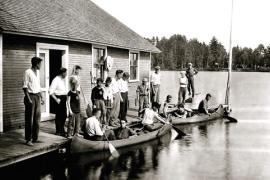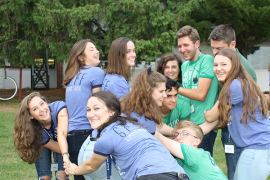Moving about confidently, two cooks snatched the garlic bread from the oven, prepped the salad bar, whipped up chocolate pudding, and a meal was complete. As the new food service director at Camp Gilmont, I marveled at the vigorous activity around me in the camp kitchen. From the outside looking in, it appeared as if an intentional routine had been established, as if the employees’ activity was magically orchestrated. However, as I scrutinized the routine over the next few days, I realized that serious change needed to happen in this kitchen. I began perusing guest evaluations and discovered ratings that were nearly perfect on food service, but much less than desirable regarding food quality.
One: Identify Habits
I had in my charge veteran cooks, who were relying on powdered potatoes, canned vegetables and pre-breaded chicken to create camp meals. Our staff were kind, friendly, and willing to help — and it showed on evaluations. However, they were so tired from overwork that they would overlook basic tasks like replenishing the drink stations or salad bar. Or, while retreating for a break for a much-needed rest after meal prep, they would occasionally be unaware there were guests in the dining hall line waiting to be served. Friendly dispositions notwithstanding, our culinary repertoire — as well as some of our habits — had to change for the good of our camp.
I determined that week that I needed to become an agent of positive change. Our faithful employees had become complacent over a number of years, developing their own routine — or set of habits — without a management presence. Food manager after manager had resigned for various reasons, leaving a gap in leadership until hiring of the next new leader. The kitchen staff had grown accustomed to fending for themselves, staying within two requirements: No more than two cooks per shift, no matter the guest numbers, and maintain a minimal budget, but try to cook quality meals anyway.
In his New York Times bestselling book, The Power of Habit, Charles Duhigg (2012) outlines the vast contrast between unhealthy routines and constructive routines within the confines of an organization, such as a camp food service. Destructive organizational habits, Duhigg asserts, are frequently caused by leaders who do not spend time thinking about the culture of their department or organization and allow it to foment without guidance. On the other hand, good organizational habits create success. The best organizations understand the importance of routines. Keystone habits create a springboard for other good habits to form, and eventually, Duhigg says, “encourage widespread change: by creating cultures where new values become ingrained.”
Two: Establish Your Vision and Strategy
I noticed four negative outcomes of the existing kitchen culture:
- Inconsistency in food quality
- Detachment from the overall purpose of camp
- Employee exhaustion
- Lack of feeling appreciated
These dear ones were cutting corners on food prep to stay within budget parameters and survive as a skeleton crew. With two cooks preparing meals for a range of 20 to 100 guests, washing all dishes, cookware, and utensils, then sweeping and mopping, they left their shifts tired and feeling unappreciated. There was little talk of the rewards of playing a part in the life of the young people who had been entrusted to our camp. The incentives to keep them going were the pay, and ironically, the ability to be their own boss.
Managers and camp directors: How can our kitchen staff display energy and positivity in guest service and food quality, and feel as if they are an important part of camp, if they are under-staffed, exhausted, and feel unappreciated?
Realizing the challenge ahead was vast, I began to pore through the best books I could find on management, leadership, business plans, and teamwork. Many experts assert that a mission statement should be the foundation of your organization. I did not have the staff nor tools to begin with a mission statement. So instead, I began with vision. Noted leadership expert John Maxwell (2001) exclaimed, “Visions spring forth from our intuition . . . . A vision must resonate deep within the leader of the team. Then it must resonate with the team members, who will be asked to work hard to bring it to fruition.” My vision for our food service was excellence.
My strategy for excellence was:
- Raise staff morale
- Improve the overall food service program
- Inspire excellence through habits and a mission statements
Three: Raise Staff Morale
Knowing our number of cooking staff was inadequate, I included kitchen staffing in my survey questionnaire for a Camping Magazine article I wrote about trends in camp food service (Truitt, 2012). Upon survey responses and budget meetings with the camp manager, I was prepared to hire two new cooks and two kitchen assistants (summer-only positions). The kitchen assistants would now take care of dishwashing, cleaning tables after meals, and sweeping and mopping the dining hall, thus enabling the cooks to concentrate fully on meal preparation.
Deciding to re-train new hires and current employees together, I began at square one, with each new staff member obtaining a food handler certification. In a two-day period prior to summer camp, we all went through the food handler certification PowerPoint presentation, slide by slide, together as a group. Stopping for question-and-answer sessions, we discussed how we needed to improve our kitchen in some ways. Many of the suggestions came directly from the employees. This gave them a sense of responsibility, ownership, and inclusion. As we openly talked about possible changes, we snacked and enjoyed a meal — takeout, so the cooks got a break from cooking. The sessions, while educational, also became a time of bonding as a team.
Completing a detailed supply inventory within my first two weeks as a new food service manager, I became aware of the lack of necessary tools and equipment our staff needed to be successful. I gradually purchased these items, starting with the small things such as mixing bowls, measuring cups/spoons, cutting boards, and knives. Replacing a dysfunctional convection oven with a double convection oven provided more capacity and saved time and steps. Enlisting staff help, we placed wheels on newly purchased storage shelves in the kitchen and walk-in pantries, etc., providing a way to roll them away from the wall to clean or retrieve any fallen items. These may sound like very basic things, but to the cooks, these small actions resonated as someone caring enough to give them proper tools to work with, more staff with whom they could share the burden, and ultimately, a means to make their jobs easier.
Another way to improve morale is to show that you care about your kitchen staff as human beings and not just employees. Parking places labeled “Kitchen Staff” were placed near the kitchen entrance, saving steps prior to 6:00 a.m. arrival and after 8:00 p.m. clock-out. A new breakroom table was added in addition to a mirror (at the cooks’ request, for placing a hat or hairnet), and a colorful nine-cubby storage unit was installed so each employee could have his or her own storage space for personal items.
Four: Improve Overall Food Service Program
Food trends had changed, and guests vocalized a desire for more varied and upscale menu options than our staff was accustomed to making. Guests were interested in eating more fresh, steamed, and baked entrees, and much less of the fried and canned foods that had become our staples. To display that wow factor, we had to build upon some of the great traditions we were known for — like our homemade rolls, cinnamon rolls, and peach cobbler — and introduce fresh new recipes.
Branding and Recipe Conversion
One of our weak routines was a lack of continuity in our prepared foods. For example, Ella made the taco meat one week according to her own unwritten recipe, and the next week Grace made her own specialty taco meat. In fact, the only written recipes in our kitchen were for our rolls and cinnamon rolls. My staff was not immediately on board with having to follow recipes, which I understood because it was an issue of personal pride in one’s own talents. However, to be a successful team and camp as a whole, we had to set aside our personal interests and work for the good of the camp. In one staff meeting, I covered the topic of branding.
“When you go to McDonald’s for a burger, do you ever notice that it tastes like a Sonic burger?” I asked, using familiar examples.
“Oh, no!” declared some employees loudly, laughing.
I continued, “Each of these restaurants is known for its unique recipes and flavors; I want us to be known for our uniqueness. To do that, we have to be consistent in recipes, in how our food tastes and looks. Our guests will return anticipating the flavor of one of our favorite foods.”
I explained that the concept of branding, according to entrepreneur John Williams, is “. . . your promise to your customer. It tells them what they can expect from your products and services, and differentiates you from your competitors” (Williams, 2015).
To begin the branding process, I found and incorporated “best” versions of recipes on popular sites such as cooks.com, allrecipes.com, etc., with my own recipes, and those my cooks suggested. To adapt these recipes to serve larger numbers, I created my own recipe conversion template in Excel, with a column for the original ingredient amounts, a column of individual ingredients, and three additional columns — traditionally labeled for 50 servings, 75 servings, and 100 servings. Recipe directions were included below these columns. Some online recipe sites will convert recipes to larger amounts. For those that do not, I manually converted the amounts using the classic Food for Fifty (Molt, 2010) conversion tables. Once these recipes were kitchen-tested, and staff and customer approved, we placed them in our new camp recipe binder.
Implementation of Special Dietary Program
Some of the camp’s newly converted recipes are for individuals with a gluten allergy or intolerance, vegetarians, and no-sugar diets. As the Great Gluten Escape was one of our most successful summer camp programs, we already had a reputation for providing great gluten-free food for campers with celiac disease. Volunteer cooking staff, consisting of camper moms familiar with cooking the gluten-free diet, trained our staff in gluten-free cooking. As more campers and guests came to camp with other unique dietary needs, we expanded our ability to serve these guests with additional knowledge and training.
Five: Inspire Excellence through Habits and Your Mission Statement
Authors Kevin Ford and Ken Tucker, in The Leadership Triangle: The Three Options That Will Make You a Strong Leader (2013), write, “Clarity drives behavior and performance.” When staff are left without clear guidelines for a lengthy amount of time, or frequent periods of time, negative behaviors creep in and job performance suffers.
A Framework for Best Habits
In observing routines in my first weeks, I referred to personnel policies first. There were no policies regarding frequency of or time length for breaks or meals, probably due to the nature of camp. In the confines of a kitchen schedule, with exact meal times and hourly employees, a written policy was needed. After all of the topics were addressed, such as using portion control scoops so as not to waste food, my policy on switching menu items without checking with me if I happened to be off duty, etc., I developed a framework for best habits and created our Food Service Manual. It was divided by topic, such as:
- Kitchen policies
- Personnel policies
- Texas Department of State Health Services policies related to food service
- ACA standards related to camp kitchens
- Contact numbers
- Forms (which included inventory and order forms, time-off request forms, a master copy of the camp time sheet, etc.)
Importance of the Mission Statement
Jim Laube, of RestaurantOwner.com (2013), affirms the power of the mission statement, declaring, “by tying everything they do to the mission statement, . . . managers are able to more effectively communicate the disciplinary (teaching) message, and that a simple mission statement is one of the most powerful tools you can have.”
Rather than crafting my own mission statement, I wanted my staff to feel ownership in the overall ministry and mission of our food service. Warren Buffett suggests “Inducing the other person to come up with the right idea is far more powerful as a motivational tool than telling them the right idea.” (Buffett & Clark, 2009). After reading together the Gilmont mission statement, our kitchen staff had a brainstorming session during staff training and shared our ideas of what our mission as a food service staff should be. I took their ideas and formed two different mission statements. After asking staff to initial their preference of the two statements, one received four of six votes, and one cook opted out of voting, which left a four to one vote result. Mission statement finalized, we framed and displayed it inside the kitchen as a visual reminder to staff. Worded based upon Philippians 2:5-7, which refers to the humble attitude of our role model and his willingness to serve others first, our new mission statement read: “Our Mission is to feed the body spiritually for the purpose and glory of our Lord, by feeding the body physically with nutritious and delicious food, served with the attitude of Christ.”
Articulating your vision and expectations through written policy, staff meetings, and the guidance of a mission statement is a crucial component in the quest for greatness.
Excellence Achieved
Notice that the last heading did not say “Perfection Achieved.” During a four-year, arduous process, I made mistakes along the way, stumbled as a leader, and wrestled with balancing being the manager and displaying empathy and compassion to my staff. As well, my team struggled with new expectations and the process of much change. They fought against preparing more recipes from scratch when it would have been easier to continue old habits, and they grumbled about my expectations — and just me as a leader at times. I was younger than each of them and had less cooking experience. But most of them truly respected me, as I did them. I am proud of my team. We changed almost all of our routines for the better and became disciplined. We received verbal accolades from campers and retreat guests. And to top it off, for three out of four years, we earned the highest possible evaluation scores in both food service and food quality. Together we achieved excellence.
Additional Resources
HBR’s 10 Must Reads on Leadership. Boston, Massachusetts: Harvard Business Review Press.
J. Maxwell’s The 21 Irrefutable Laws of Leadership: Follow Them and People Will Follow You. Nashville, Tennessee: Thomas Nelson, Inc.
Parkinson & Grossman, Becoming a Successful Manager. New York, New York: McGraw-Hill.
Z. Ziglar’s Top Performance: How to Develop Excellence in Yourself and Others. Grand Rapids, Michigan: Revell, Baker Publishing Group.
For details on how to implement a Food Allergy Action Plan in your kitchen, see “The Big Eight . . . and Other Culinary Menaces to Camper Society” in the March/April 2014 issue of Camping Magazine or online at ACAcamps.org/resource-library/articles/big-eight-other-culinary-menaces-camper-society.
Photo courtesy of Camp Michigamme, Michigamme, Michigan.
Author’s note: Names have been changed to protect anonymity.
References
Buffett, M. & Clark, D. (2009). Warren Buffett’s management secrets: Proven tools for personal and business success. New York, NY: Scribner, Simon & Schuster.
Duhigg, C. (2012). The power of habit: Why we do what we do in life and business. New York, NY: Random House.
Ford, K. & Tucker, K. (2013). The leadership triangle: The three options that will make you a stronger leader. New York, NY: Morgan James Publishing.
Laube, Jim. (2013). The power of a mission statement, RestaurantOwner.com — profit tip of the week, from subscription.
Maxwell, J. (2001). The 17 indisputable laws of teamwork: Embrace them and empower your team. Nashville, TN: Thomas Nelson, Inc.
Molt, M. (2010). Food for fifty (13th Edition). Upper Saddle River, NJ: Prentice Hall.
Truitt, K. (2012). Current challenges and trends in camp food service. Camping Magazine. Martinsville, IN: American Camp Association.
Truitt, K. (2014). The big eight . . . and other culinary menaces to camper society. Camping Magazine. Martinsville, IN: American Camp Association.
Williams, J. (2015). The Basics of Branding. Retrieved from entrepreneur.com/article/77408
Kimberly Whiteside Truitt, CFM, has been food service director for Camp Gilmont and Camp Zephyr. Kimberly enjoys writing/editing and is married to Thomas and mom to Harrison and Benjamin.



